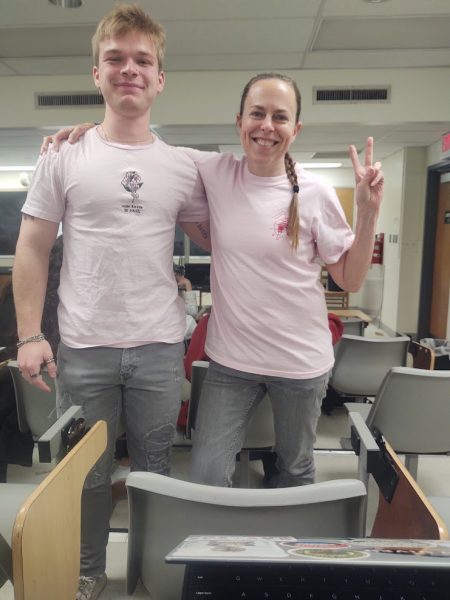Movie Review: ‘It: Chapter Two’
For the most part, “It: Chapter Two” follows the adult members of the Losers Club. As kids, they defeated Pennywise, the shape-shifting clown that resides in Derry, Maine. 30 years later, they have successful lives, and overall, their memories of childhood are cloudy. After it becomes apparent that Pennywise has awaken, Mike Hanlon (the only member who stayed in Derry) calls the other Losers. The group returns to Derry, hoping to destroy Pennywise once and for all.
The first 10-15 minutes of a film are monumentally important. It’s the job of a filmmaker to hook audience members. In this case, director Andy Muschietti opens the film like a man possessed. “Chapter Two” introduces us to Adrian Mellon and Don Hagarty, a gay couple who reside in Derry. During the local festivities, a homophobic group corners and beats the couple to a pulp. I must be honest: This opening will offend many viewers. In terms of its violence and language, this opening is the stuff that reality is made of.
This sequence is short, but Muschietti makes the most of every second. It’s not pointless gore. It’s social commentary wrapped up in the guise of a horror film. Consider the homosexual couple; they aren’t caricatures. They are a loving, selfless unit filled with peaceful aspects. This efficiency enables us to see the couple’s true colors. From there, we are fed to the dogs.
The best sources of cinema take real life aspects and portray the events through the prism of fantastical storytelling. When done correctly, cinematic scenes become a form of societal expression. Here we have a beautiful portrait of small-town America. But in classic Stephen King fashion, we realize that appearances are deceiving. This opening, while graphic, is the definition of brutally honest. It holds a mirror up to our corrupt society, showcasing the idiotic forms of homophobia that lie within. Like King, Muschietti understands that often times the monsters of reality are scarier than the creatures of narrative mythology.
Unfortunately, the rest of the film pales in comparison. Let me be clear…”It: Chapter Two” is an ambitious adaption, ushering in a new definition of cinematic horror epics. Clearly, Muschietti and company respect King’s source material. Through the production design, their love of horror is more than evident. The entire flick looks like a majestic nightmare. Sadly, even with all of its loving qualities, “Chapter Two” ends up being an overlong picture, chock-full of narrative fat that slows down the story.
The joy of “Chapter One” came from its singular vision, fully committed to the exploits of the younger characters and their tortuous circumstances. The end result was a flick that tapped into the turmoil of innocence being minimized. We felt like an extension of that group. And even though the movie was abnormally long for a horror film, it never dragged because the characterizations were infinitely personal. In “Chapter Two,” it feels like Muschietti and Gary Dauberman (the screenwriter) are disinterested in the adult group.
Like a man-child who self indulgently observes the past, “Chapter Two” ruins its unique potential. In many ways, its special nature is stunted by its affinity for the previous film’s main characters. Many of the flashbacks take us to the characters’ younger days. In particular, we are given additional scenes that attempt to flesh out the kids’ experiences that summer, but why? The acting in the first film was so tremendous. We completely believed their torturous circumstances.
King’s novel and Tommy Lee Wallace’s miniseries were justified in the utilization of flashbacks. Those stories worked from a nonlinear perspective, providing personalized context through the employment of flashback sequences. But in this case, the context has already been set. We know who these characters were. Now, we need to see an uninterrupted story that shows us who these characters have become. A flashback here and there is fine, because a glimpse into the past perfectly parallels the remembrance of childhood. But when specific scenes showcase elements that barely affect the larger narrative, the film becomes tedious in the worst way possible. As the pointless flashbacks came into play, I held out hope that Pennywise would turn up in real life and put me out of my misery.
Yes, this film disappointed me, but I’d be lying if I said that the film didn’t have brilliant parts. Credit must be given to the cast. They construct older characters that seem viable. Overall, the cast’s chemistry manages to recreate glimpses of magical comradarie, which was fully intact in the previous film. It’s just a travesty that these performers aren’t given more well-rounded characters. The adult characters’ lives are quickly glossed over, and in retrospect, this fast-forwarding effect feels like a huge misstep. We do not feel a developed connection to their current lives.
Even though the entire cast works wonders, there are clear standouts. As an adult Beverly Marsh, Jessica Chastain turns in a wonderful performance, but the script’s decision to mostly ignore her victimized existence as an adult feels irresponsible, especially in this era of female empowerment. Isaiah Mustafa wonderfully portrays an adult Mike Hanlon. If you thought that Mike was underutilized in the first flick, you will be pleased with his role in this film. Like the novel and miniseries, Mike brings the team together. In many ways, he’s the cinematic glue.
As an adult Richie Tozier, Bill Hader becomes an infectious force of nature. Obviously, his comedic talents are top notch. But most importantly, Hader is able to create believable forms of petrification. An abundance of Hader’s humor works, because he accurately portrays a character who uses humor as a defense mechanism. Sadly, the film as a whole uses humor at inopportune times, which ultimately undercuts much of the seriousness.
Specific phrases are obvious. Water is wet. The sun is hot. Bill Skarsgård is great as Pennywise. This time around, Skarsgard’s performance consists of enhanced campiness. The humor combines elements of awkwardness and creepiness. This portrayal makes sense, considering the fact that Pennywise was defeated by the children in the last film. Skarsgard, with his strange mannerisms and devilish sincerity, evolves the horror icon. Very quickly, we realize that Pennywise is a bit unsure when it comes to communicating with children. He’s not as confident as he once was.
Unfortunately, Pennywise’s visual presence onscreen isn’t as effective. In the first film, Pennywise was a force of great mystery. He was shrouded in darkness, and most times, we would only see parts of him. In this sequel, we see his full form in broad daylight. To put it simply, the mystique is gone. The film undercuts Skarsgard’s acting by employing computer generated imagery that sticks out like a sore thumb. The instances of CGI make the ensuing carnage less visceral, and often times, it overshadows Skarsgard’s brilliance.
All in all, film is subjective. “It: Chapter Two” didn’t wow me, but maybe it will wow you. I recommend that you give the film a chance. Form your own opinion. And from the bottom of my heart, I hope that you have a great time.
My Grade: C-
Dillon McCarty can be contacted at [email protected].
Your donation will help continue the work of independent student journalism at Marshall University. If you benefit from The Parthenon's free content, please consider making a donation.





